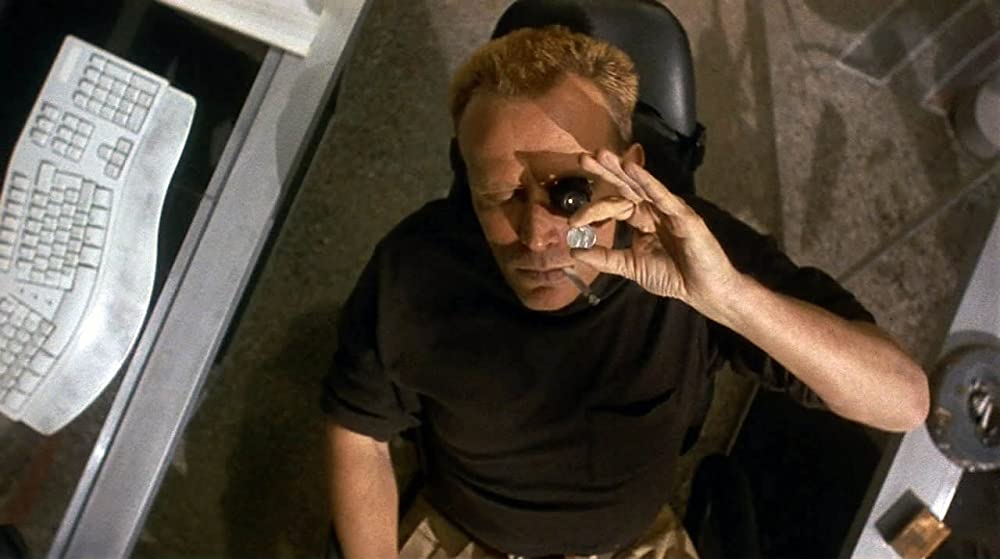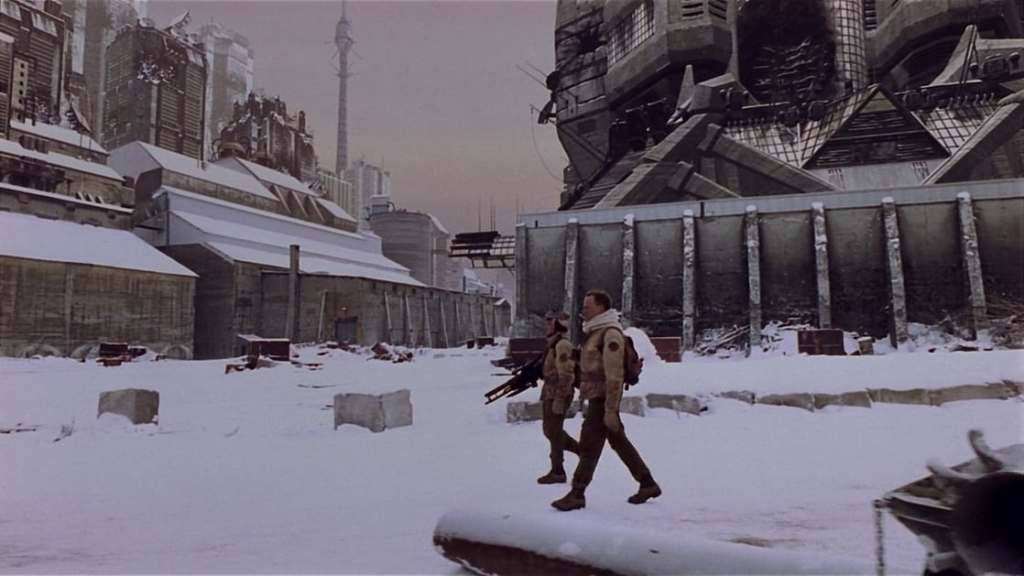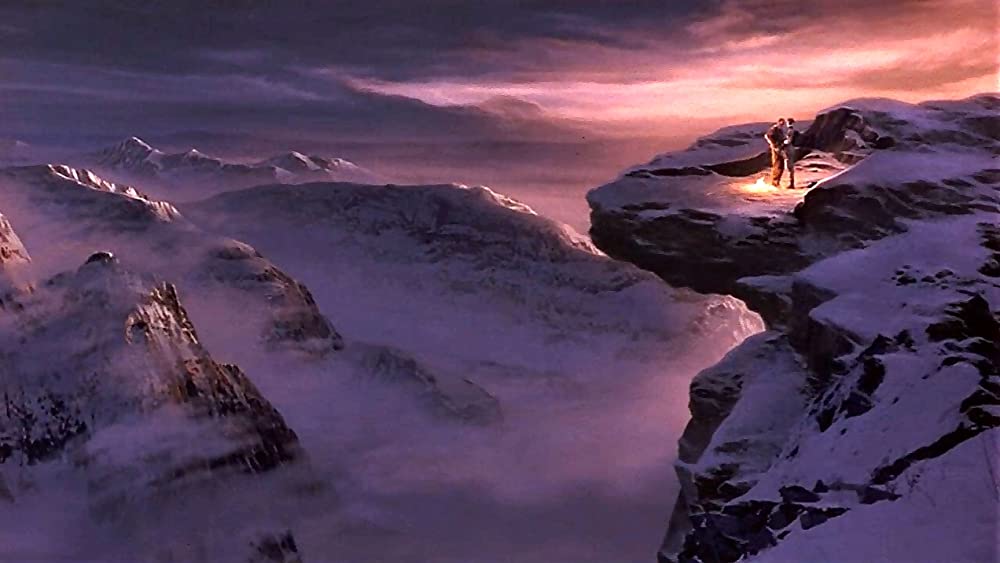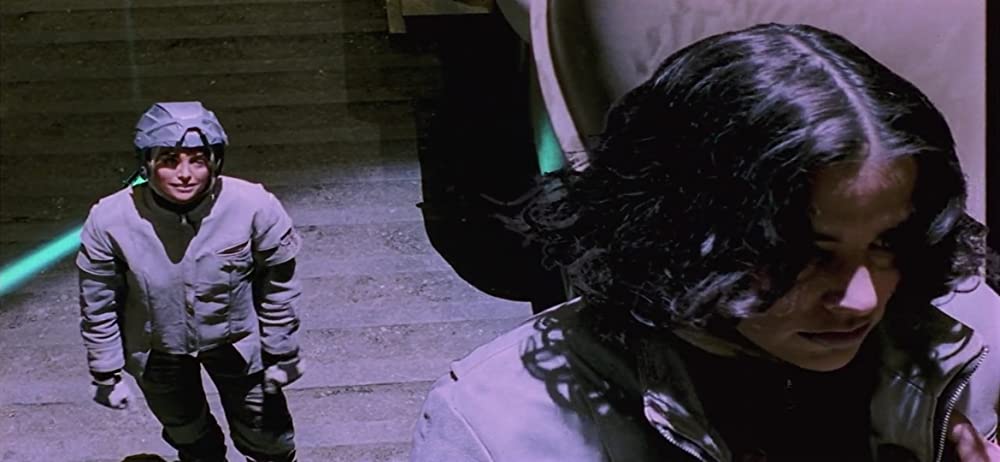
Philip K. Dick’s 1953 short story “Second Variety” is maybe the exact opposite of Gog, despite coming from the same Cold War context—it is absolutely an existentialist nightmare about our technology becoming self-replicating and ultimately superseding humanity, to the point where the armed conflict between humans that led to their creation is completely invalidated. It is quintessential killer robot fiction, and it is also classic Dick, concerned with identity and human behaviour, containing imagery that is sometimes both ridiculous and highly disturbing, and a final line with implications I still think about all the time.
It also has plenty of interesting visuals to work with, so a movie adaptation was certainly on the table after the success of Total Recall created a potential mini-industry of PKD-based films—and what do you know, the adaptation of “Second Variety”, called Screamers because it was the nineties, was co-written by Total Recall co-writer (and also Alien co-writer/Return of the Living Dead director) Dan O’Bannon (alongside Miguel Tejada-Flores, whose other best known work is…Revenge of the Nerds and The Lion King? Okay, whatever you say.) The movie manages to recontextualize the story for the post-Cold War age while keeping the desolate and paranoid tone, for the most part, and also gives it plenty of that cynical nineties dinginess that was so omnipresent in both horror and sci-movies of the time (the director, Christian Duguay, got his start directing straight-to-video sequels to Scanners, so it’s about what you’d expect.) While it’s clear that part of the impetus for this was its potential for violence and weird special effects, there are enough ideas here to make it a little bit more than that.

One of the big changes from “Second Variety” is sort of a reversal: the original story took place on a devastated Earth, with most people having relocated to a colony on the moon; in Screamers, the action takes place on a distant planet, with Earth apparently doing just fine, making it feel less apocalyptic as a result. The conflict that instigates the plot takes out the West vs. USSR backstory, instead pitting rebellious workers against a corrupt corporation, explained with a classic text scroll/VO combo at the beginning of the movie (which then later elaborates on it further in dialogue…come on, movie people, pick one style of exposition.) You see, people discovered a useful element on this planet, but when the New Economic Bloc sent their science and mining crews to go get it, they discovered that it leaked deadly radiation and the crews refused to continue operations, leading to the NEB hiring mercenaries to get them in line and then going right into the nuclear bombings. In response, the workers (calling themselves the Alliance) and their allies on Earth designed war robots, called Screamers because of the high-pitched sound they make, to use against the NEB, and even built an automated underground factory to produce them. Now, having the rag-tag group be the ones who invented the killer robots maybe makes a little less sense than in the original story, where it was the UN—but in both cases, having the ostensible “good guys” be responsible is a deliberate creative choice.

The actual plot focuses on Alliance leader Commander Hendricksson (played by Peter Weller, who brings a proper “done-with-this-crap” weariness to his performance), whose outpost in the snowy wastelands hasn’t seen any activity from the NEB in quite some time, until a single soldier delivers a message to them before being cut to pieces by the robots—depicted as little balls covered with buzzsaws, which is accurate to the story, but will also likely remind you of the spheres from Phantasm—followed by an Alliance spaceship crashing in their backyard with only one survivor. From this, Hendricksson learns that the NEB brass are interested in brokering peace, but also that the big wigs on Earth found a completely different planet with the same material and less danger, and decided to simply abandon the people still left on the first planet—it’s a very anti-authority tone that was common in the nineties, but is also a recurring theme in Dan O’Bannon’s films. Hendricksson decides to go out and talk to the NEB himself, only bringing along the soldier from the crashed ship, who in the first half of the movie is an irritant who is always talking. As they travel across the landscape, they eventually discover that not only are their enemies more or less on their last legs, but that the robots have been experimenting with new models, which range from more animalistic ones (like the fairly adorable “reptile”, which is just a buzzsaw with legs) to ones that resemble humans, beginning with a young boy carrying a teddy bear that is designed to convince unwary people to let it into their bunkers. As in “Second Variety”, having the robots evolve around taking advantage of human sympathy is an amazingly sinister concept.

Much of the movie takes place in either bare wastelands or abandoned factories and bunkers, those places beloved by science fiction movies, but you get some glimpses of dirtbag future aesthetics early on in the film (similar to the one in Hardware): low lights, video screens showing indecipherable imagery, people wearing big sunglasses for no reason (although at one point, we see that the soldier’s sunglasses are actually VR porn goggles), basically a lower rent junkyard version of Total Recall. They even find a way to make sure everyone still smokes, by making them anti-radiation cigarettes. All that stuff is pretty well abandoned once Hendricksson leaves the bunker, though, entering a world that is more or less devoid of all life, a clear side effect of not just the devastating war, but of the robots doing their job far more effectively than their creators imagined. The third act takes a turn from that, too, with a few wide shots of the landscape that are actually kind of beautiful, and often paired with swelling music.

As for the effects, the spheroid Screamers (called Claws in the story, and Swords here) and the reptile are portrayed with stop-motion, and have that black-screen compositing fuzziness that I associate with mid-to-low budget nineties SFX, which does make some of the effects come off as a little goofy. Of the humanoid robots, the one that appears the most is the kid model, called David, and you have to wait a bit for the scene where dozens of them appear together, which in the story was a fairly indelible image that completely changed the nature of what was happening. At the same time, I think it’s pretty clear that the people behind the movie just thought having scenes where our heroes mow down kids with gigantic machine guns (pretty much all the guns in this movie are excessively massive) and rocket launchers was the bee’s knees, and made it a central action set piece. Even with those scenes of mass robot child murder, though, this movie is surprisingly not as violent as I thought it would be—how could I not think so, the robots are made of buzz saws!—and in those terms is probably on the lower end of the R rating (but with lots of cursing and brief nudity.)

The reveal of the other human models is gradual, and once Hendricksson and the soldier meet a trio of NEB survivors and learn about the new varieties of robot, there are a few scenes of The Thing-style tension as the characters suspect each other of being one. The use of behavioural hints to determine humanity—the biggest being repetitive phrases and actions, which gets used well in a scene pulled straight from the story where they go back to the Alliance bunker and get into a conversation with an obvious robot—is another recurring theme in Dick’s work (it’s a big part of “Do Androids Dream of Electric Sheep”/Blade Runner, for example), and like in many of those stories, it turns out that those signals are not as cut-and-dry as people would like to think, as the robots simply create more sophisticated models that can even imitate human physiology and complex emotions.

That last part comes into the ending, which is the single biggest change from “Second Variety.” Having read the story, I already surmised that the black arms dealer Jessica (played by Jennifer Rubin from Nightmare on Elm Street III) would end up being a robot, even though the movie tries to mislead you into thinking she isn’t by having Hendricksson cut her and see that she bleeds. They also fall in love very close to the end of the movie, which seems to come out of nowhere (although Hendricksson did get to see her undress not long after they first met, a scene that is certainly not gratuitous), but I guess when you think about it, the guy is probably pretty desperate for any real intimate human relationship at that point. Except, whoops, when they get to the secret escape pod in the mountains, another Jessica shows up (alongside a robot that stole the appearance of Hendricksson’s second-in-command who was killed off-screen) and reveals the ruse, but the first Jessica has decided that she doesn’t actually want to kill all humans, leading to a doppelganger martial arts battle which also involves disintegrating lasers and a fiery death by jet ignition. This ends with a modified version of that final line that so impressed me in the story, where they contemplate the fact that the robots have already started manufacturing weapons to destroy each other—basically, that despite how advanced and efficient the robots are, they will likely suffer the same fate as humanity. The movie version adds on the idea that the robots are also now capable of love and compassion, although I’m not sure the story really does much to justify that, and so this much less bleak conclusion (even with the obligatory sequel stinger before the credits) feels like a very Hollywood addition.

Those sorts of changes don’t ruin the movie as a whole, but I do think they make Screamers less interesting overall than its source material. Still, it has to be commended that they managed to capture the many of the nuances of “Second Variety” as well as they did, and didn’t even go off into excessive grossness along the way (the VR porn goggles aside). Not to take anything away from other people on the production, but I tend to think that it was O’Bannon who made it that way, as he clearly found many commonalities between Dick’s work and his own, and the parts of the movie where they align are probably the strongest material. The original story is one of the more frightening depictions of killer robots, and while I’ll always recommend it first and foremost, the movie version is a decent enough rendition of its themes and its atmosphere.